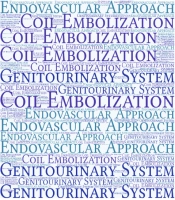1. Background
Transcatheter embolization is a growing management approach for the treatment of bleeding due to renal trauma, renal cell carcinoma (RCC), bladder hemorrhage, angiomyolipomas (AMLs), medical renal disease, vascular malformations, complications following renal transplantation, palliation for metastatic renal cancer, symptomatic hematuria preoperative infarction of renal tumors and other urologic disorders (1-3).
Nowadays, this effective and minimally invasive alternative procedure has been used widely and indications are expanding gradually. There are various materials for occlusion and embolization of bleeding vessels. For these purposes, various therapeutic approaches and different materials with vascular sclerosing potential have been used (4). By advancement of more precise embolic agents for embolization of feeding arteries and smaller delivery catheters this method has gained popularity among interventional urologists (1, 5). Despite its simplicity and effectiveness, this approach requires sophisticated skills because undesired side effects may emerge owing to insufficient skill. Each center needs to create its own to understand the success and failure rate of this strategy and to improve applicants' learning curve. Hereby, we report case series of endovascular genitourinary (GU) angioembolization procedures performed in our center.
2. Methods
In this study, we report cases who underwent successful angioembolization. In 76 cases of bladder transitional cell carcinoma cells, life-threatening gross hematuria was treated by coil embolization of the bladder artery at two sequential sessions separated by a week to prevent necrosis. Eight cases of bladder and renal arteriovenous malformation (AVMs) underwent coil embolization using injection of water-soluble material in the feeding artery of tumor or AVM via 2.9 F micro catheter or 5-F catheter located in the feeding artery of pathologic site to obstruct vascular supply. We dissolved one bottle of PVA with particle size of 100 - 800 μm in 20 mL of normal saline and 20 mL of contrast agent. This solution was gently infused, allowing the contrast agent to linger in the target tissues. Then, the feeding artery was plugged using many coils to prevent revascularization. In the event that bilateral embolization was required, the side with predominate supply was blocked first, followed by the contralateral side during the second session 10 - 14 days later. Angiograms revealed renal artery pseudoaneurysms in individuals with hematuria (33 cases) following percutaneous nephrolithotomy (PCNL). We only employ pushable coils for closing the blood stream to pseudoaneurysm in location of renal stone after procedures performed on PNCL for closure of feeding artery of pathologic site. Pushable coils have lower cost compared to other types of available coils with filament diameter of 0.035 inches. We also used coils with helical diameter of 1 to 1.5 manifold of vessel diameter. Coil length was also dependent on the length of target vessel needed to be plugged without obstruction of side branch vessels. To deploy coils, coils were connected to 5F catheter or to the microcatheters. Renal angiomyolipomas (29 instances) were treated with coil embolization. In three cases of benign prostatic hyperplasia (BPH) high risk for surgery, coil embolization of main prostate artery was performed. Five cases of hematuria in the context of acute renal damage were also successfully treated with GU endovascular therapy.
3. Results
The success rate for angioembolization of bladder transitionary carcinoma cell was 100% but in 2 cases hematuria continued due to another GU source of bleeding. Coil embolization of bladder and renal AVMs was successful in all cases. Cessation of hematuria after PCNL was successful in all cases except hematuria recurrence in on one case after one week that was closed again successfully. Coil embolization of renal angiomyolipomas was successful in all cases. Coli embolization of BPH reduced urinary symptoms after 3 month. Hematuria due to renal trauma was ceased by coil embolization in all cases. We did not observe serious complications in our case series, but hematoma occurred in 3 cases which was easily controlled. Contrast induced nephropathy and fever occurred in 12% and 20%, respectively. Pain duration was within 4 - 10 days after embolization of AVM or tumor. Embolization could be done in the case of high output priapism and varicocele but we did not perform these procedures because of no referral.
4. Discussions
Therapeutic endovascular embolization of feeding artery or embolotherapy is growing rapidly by the advancement of novel embolic agents (5). Patients with complex urologic manifestations are quite a real challenge for working physicians. Indeed, procedures such as pyeloplasty, laser lithotripsy and endopyelotomy are associated with inherent risk of vascular damage (6). In these cases, trans catheter embolization is effective in the treatment of these vascular injuries. Endourologic interventions have been demonstrated to be valuable in the treatment of acute extravasation in trauma setting, renal AVM, prophylaxis for blood loss before resection of vascular tumors like RCC and angiomyolipomas (7-10). The observed problems are all perioperative in nature, ranging from impaired renal function to embolization of non-target organs, manifesting as renal failure and infarction of the contralateral kidney, coil migration, renal vein and inferior vena cava thrombosis, and so on.
This technique necessitates highly trained internationalists, nurses, and technicians, as well as a well-established center-based team approach with a high success rate. In this study, we have achieved high success rate in the endovascular treatment with lower rate of complications. There are many cases of endourologic problems and percutaneous treatment is a good therapeutic option especially in older or comorbidities. We offer advancement of these techniques especially in centers with high expertise and trained interventionists.
4.1. Conclusions
Coil embolization of the GU system is a relatively safe and approved approach that could be employed in impoverished nations with a high success rate and a low failure rate.
